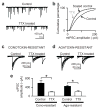Reduction in endocannabinoid tone is a homeostatic mechanism for specific inhibitory synapses
- PMID: 20348918
- PMCID: PMC2860695
- DOI: 10.1038/nn.2517
Reduction in endocannabinoid tone is a homeostatic mechanism for specific inhibitory synapses
Abstract
When chronic alterations in neuronal activity occur, network gain is maintained by global homeostatic scaling of synaptic strength, but the stability of microcircuits can be controlled by unique adaptations that differ from the global changes. It is not understood how specificity of synaptic tuning is achieved. We found that, although a large population of inhibitory synapses was homeostatically scaled down after chronic inactivity, decreased endocannabinoid tone specifically strengthened a subset of GABAergic synapses that express cannabinoid receptors. In rat hippocampal slice cultures, a 3-5-d blockade of neuronal firing facilitated uptake and degradation of anandamide. The consequent reduction in basal stimulation of cannabinoid receptors augmented GABA release probability, fostering rapid depression of synaptic inhibition and on-demand disinhibition. This regulatory mechanism, mediated by activity-dependent changes in tonic endocannabinoid level, permits selective local tuning of inhibitory synapses in hippocampal networks.
Figures








References
-
- Trasande CA, Ramirez JM. Activity deprivation leads to seizures in hippocampal slice cultures: is epilepsy the consequence of homeostatic plasticity? J Clin Neurophysiol. 2007;24:154–164. - PubMed
-
- Bausch SB, He S, Petrova Y, Wang XM, McNamara JO. Plasticity of both excitatory and inhibitory synapses is associated with seizures induced by removal of chronic blockade of activity in cultured hippocampus. J Neurophysiol. 2006;96:2151–2167. - PubMed
Publication types
MeSH terms
Substances
Grants and funding
LinkOut - more resources
Full Text Sources
Other Literature Sources

